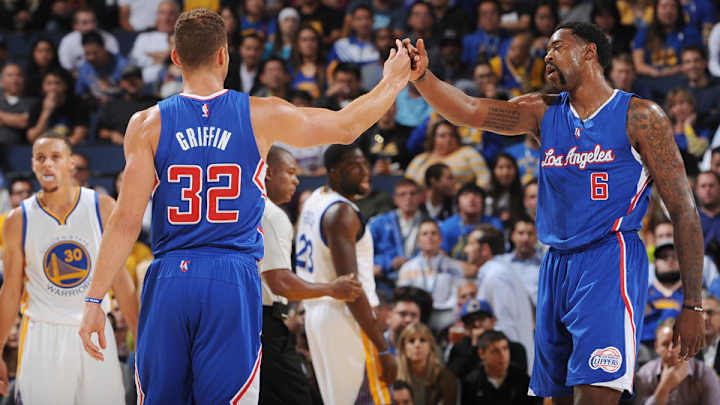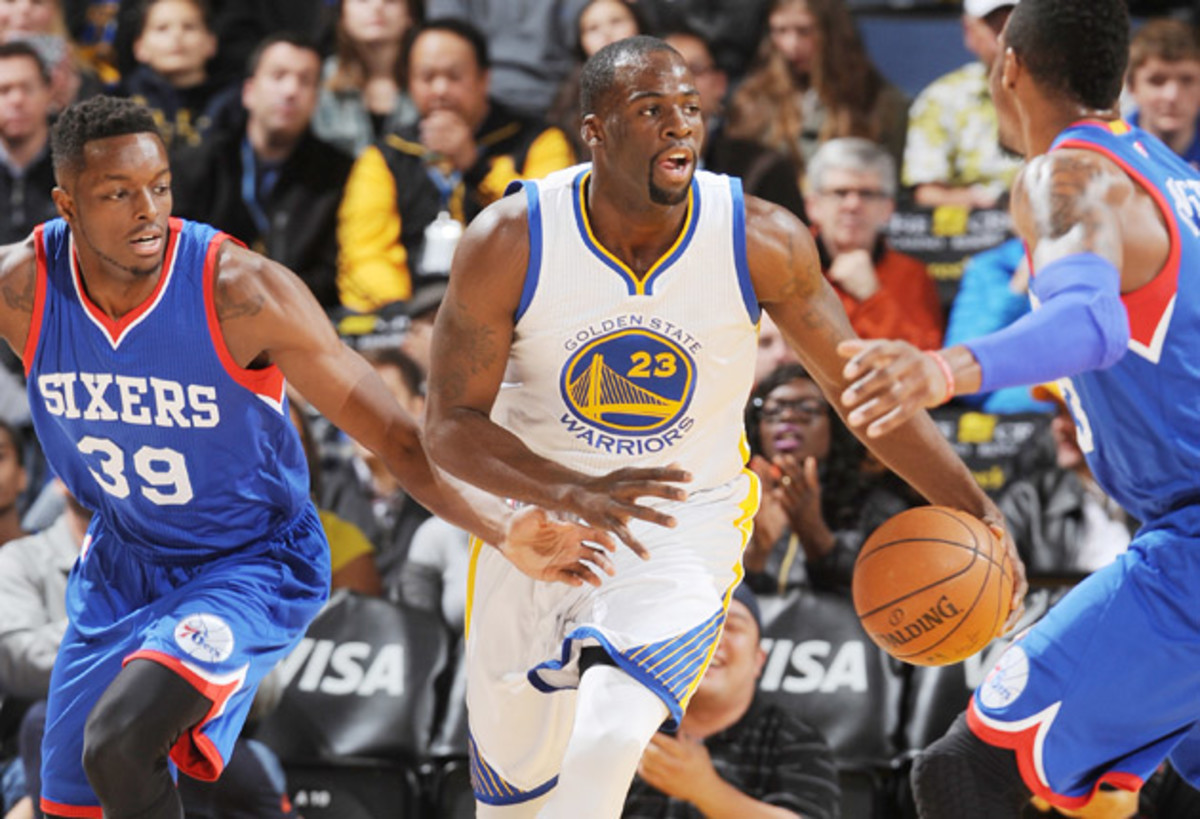The Fundamentals: Examining the NBA's best big-to-big passing duos

There's something wonderfully delightful about the work of a big-man playmaker. That they're also highly functional is a nice kicker. When utilized consistently, a power forward or center with ball skills can be just as valuable as a stretch option at those positions – if not more so. A skilled frontcourt passer is a mechanism for high efficiency. Having two such players allows for transcendent offense.
For today, however, we narrow our scope to a more specific playmaking connection: Big-to-big passing. There's a novelty to it, to be sure. But those power players who consistently set up one another attack defenses at the point of rotation. Such action can compromise even the stoutest systems in the league, putting this kind of dynamic on valuable grounds for its playoff applications. Below are the most prolific big-to-big passing combinations in the league, each unique in their operations*.
*For the sake of this particular exercise, we're going to sidestep the Spurs, for whom big-to-big passing is a title-affirmed way of life. Despite injuries, they're the gold standard for this kind of action on a team level, and for that we bow in reverence.
Blake Griffin and DeAndre Jordan, Clippers
In terms of one-way connections, no big-to-big pairing has totaled more assists this season than Blake Griffin to DeAndre Jordan. For that matter: Griffin has just four fewer assists to Jordan (45) than does Chris Paul (49). Every team in the league balances the responsibility for shot creation among multiple parties. Few, though, find the kind of equilibrium that Los Angeles has between Paul and Griffin's work as initiators.
• MORE NBA: Midseason awards | SI's All-Star starters | Dream Dunk Contest
SI's 2014-15 NBA Midseason Awards
The crux of that balance is Griffin's comfort level at range. Griffin grows exponentially more dangerous as a scorer the closer he gets to the rim, but his handle and vision make him a terrific facilitator from any space on the floor. This turns his pick-and-rolls with Paul into a flex point for the offense. Should Paul face unwanted pressure, he can reroute the ball to Griffin without concern for timing or position. Some bigs need to make a catch within two strides of the basket or the space that can be covered with a single dribble. Griffin isn't bound in that way, and as such makes a lot of his pick-and-roll catches high on the floor as opponents look to trap Paul.
A quick response from Griffin then demands impossible coverage. His push toward the basket warrants instant (if not preemptive) response, else Griffin will leap into a powerful finish. Even after timely rotation, this often leaves Jordan just free enough to register as a lob target:
So many of these sequences affirm Griffin's passing acuity. Watch closely and you'll see him trigger the lob just as a defender or two begins to lurch his way. From that point there is no return. Jordan is tall and bouncy enough that Griffin can put the ball where only he can find it, and those that might otherwise have denied Jordan position have since abandoned their posts. The play develops so quickly that taking a hard foul isn't a realistic option.
These kinds of feeds – many as natural byproducts of the Clipper offense – make for the bulk of Griffin's table-setting for Jordan. The two also have a synergy in transition, though it's not as highlit as you might expect. Fast-breaking alley-oops are more occasional for these two, as far more often Griffin will find Jordan in a deep seal under the rim. Jordan's post game is embryonic, but he's so big that standing near the hoop amounts to a free score. That he can finish with reverse dunks without having to so much as pivot leaves a sealed defender helpless.
There's no question that the interior focus of both Griffin and Jordan can be inconvenient at times for the Clippers, but the chemistry between the two is undeniable. That kind of connection gives them a gravity in their own way; when Griffin has the ball in his hands, help becomes far more difficult and Jordan must be treated as an active threat.
Al Horford and Paul Millsap, Hawks
Potent though the Griffin-to-Jordan combination is, the inverse order – Jordan-to-Griffin – has yielded just four assists this entire season. Theirs are distinct, unchangeable roles. The relationship between Horford and Millsap, on the other hand, is fluid from second to second. On one possession, a high-posting Horford might set up Millsap deeper in the paint. On the next, Millsap might drive into an assist as Horford cuts baseline. No two bigs in the league this season have totaled more mutual assists (54), in part because none are as flexible in the who and how of playmaking.
Breaking down how the Hawks can carry their success past this season
The passing of this pairing has no consistent geometry. There are post-ups and kick-outs, pick-and-roll bail-outs, double-team draws and cuts into fade-outs. Oh, the places they'll go. Horford and Millsap play off one another in mutual capability, sliding around within Atlanta's offense and making whatever screens and passes need to be made. Sometimes that involves playing an active role in offensive initiation. At others, it allows them to flow into a play by setting an off-ball screen, catching in space, and continuing the ball on its path to the open man:
In that, Horford and Millsap are the point of separation between a good Hawks offense and a great one. The league has seen plenty of unselfish teams that prioritize ball movement. Atlanta takes the concept a step further by turning to five players who can both shoot and pass, presenting a constantly shifting web of scoring threats. The ball won't stop with Horford or Millsap any more than it would stop with Kyle Korver. Their quick decisions make the offense go, particularly in contrast to those bigs who need to survey the floor before making the right pass.

Draymond Green and Marreese Speights, Warriors
There are certainly higher-profile passing combos than this, but what Green and Speights lack in reputation they make up for in uncanny frequency. Golden State's bigs rank fourth overall (30) in the entire league in total mutual assists. The catch in that statistic is that they've played roughly a third of the minutes together than Griffin and Jordan have, and roughly half the minutes together that Horford and Millsap have.
For the record, that also puts the Green-Speights pairing higher on the mutual assists leaderboard than Memphis' Marc Gasol and Zach Randolph and Chicago's Pau Gasol and Joakim Noah – again in far fewer minutes. This is insane.
The All-Ignored Team: Most slighted players in 2015 NBA All-Star voting
Generally speaking, the success between them boils down to Green's situational awareness and Speights deciding to make a stealth run at this year's MVP. Green doesn't have the vision of a player like Griffin, for whom the court seems to unlock. His passes are simple. His decisions are practical. Where he finds advantage is in recognizing an opening before the defense does, turning the improvised cuts of his teammates into something actionable.
In a sentence I never thought I'd type: This plays out to amazing effect opposite Speights. The two have a pick-and-roll rapport in the same way that Horford and Millsap do. When one runs into some defensive clutter after making a catch in the lane, they naturally look to one another as an outlet. Green, in particular, does a fine job of making the dump-off pass to beat an incoming defensive rotation. He also takes advantage of ball-watching defenses that now believe in the threat of his three-point shot. After Golden State's offense finds Green outside, he can rise into a ploy attempt before rocketing a pass to Speights in the lane.
The most preposterously successful source of their assists, though, comes from Green facilitating plays from the high post opposite Speights running curls a la Kevin Durant:
You can't make this stuff up. Speights takes those shots and makes them, and at this point it's clear that Green – even when sharing the floor with Stephen Curry and Klay Thompson – looks for him as a scoring target. He does so enough as to out-assist most every other combination of bigs in the league, and to add another touch of spice to a robust Warriors offense.
Assist data courtesy of NBA.com and accurate as of January 20.
